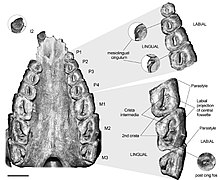Mesocarnivore
[1] Mesocarnivores are from a large family group of mammalian carnivores and vary from small to medium sized, which are often less than fifteen kilograms, the human is a notable exception.
[2] Mesocarnivores are seen today among the Canidae (coyotes, foxes), Viverridae (civets), Mustelidae (martens, tayra), Procyonidae (ringtail, raccoon), Mephitidae (skunks), and Herpestidae (some mongooses).
The red fox is also the most common of the mesocarnivores in Europe and has a high population density in the areas they reside.
[5] These animals play an essential role in the function and system of the ecosystem, since the elimination of apex predators.
Mesocarnivores, as a part of the mammalian carnivore family, play a large role in the ecosystem, due to their prey-drive effects and impact on its functionality and structure.
They are an important part of the ecological function, as their small to medium size allows them to disperse seeds that hypercarnivores cannot.
[7] In some mesocarnivores, including the masked palm civet and hog badger, activity patterns peak during the night.
For example, otters (Lutrinae) are specialised in swimming in water, however find it difficult to move on land.
[10] Large and small mammals are considered as prey to these mesocarnivores, as well as different herbivores, depending on what food is most readily available to these animals.
For example, the yellow-throated marten and Siberian weasel change their feeding behaviours in winter when limited fruits are available and convert to small mammal prey.
They can live up to a lifespan of fourteen years, with their size ranging from 81–94 cm (32 to 37 inch) head to body, and weigh 9–23 kg (20–50 pounds).
Their physical characteristics include short limbs, a pointed snout and small upright ears, with a body length of 75–90 cm (30–35 inch) long.
[16] Raccoons weight varies from 10–20 kg (22–44 pounds) and have a furry coat that resembles black, grey and brown shades.
[16] These mesocarnivores catch majority of their food in water, including crayfish, frogs and other marine animals, as well as feeding on rodents and other plant material.
Mongooses are animals with physical features including short legs, pointed snout, minute ears and a long tail.
These mesocarnivores can be easily recognized by their black fur with a thin white stripe from their nose to their forehead.
There are two thick white stripes that run along the sides of their back and continue to their furry, bushy tail with grey shades.
Their physical characteristics include a variation in size and colour from yellow to shades of dark brown, short legs, small, round ears and slender bodies, with thick coats.

